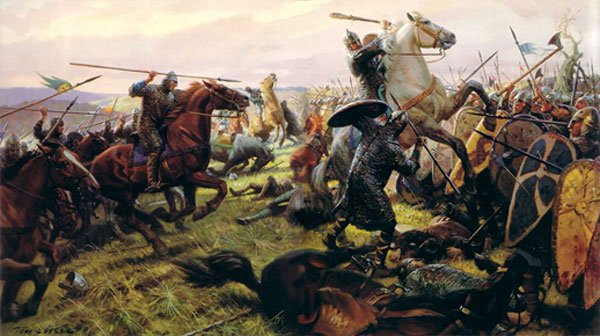Do you know what the Bayeux Tapestry is actually about?
It’s about the Norman Conquest. Everybody knows that.
Well, not exactly.
But it is. All the pictures in it are about the Battle of Hastings.
Well, no. They’re not. They’re about all sorts of other things as well.
I have seen the Bayeux Tapestry. It’s full of pictures of chain mail and housecarles and battle-axes and horses charging and men getting killed and Harold getting an arrow in his eye. If that isn’t an account of the Battle of Hastings, what is?
It may contain pictures of chain mail and housecarles and battle-axes and all the things you said, but it is not a proper account of the Battle of Hastings.
Do you mean to say that it doesn’t tell you about the Battle of Hastings?
Yes, it does. But it only tells you what the authors want you to know about the Battle of Hastings.
Well, of course, they can’t put absolutely everything in. It would make the Tapestry absolutely enormous, and it’s over two hundred feet long already. Nobody would take the trouble to wade through anything that size.
That is precisely what the authors rely on: that you will be satisfied with what you see. They persuade you to accept their version of events. They persuade you to accept that that is all you need to know. But it is not true; you haven’t seen it all.
What do you mean by ‘all’?
The full picture: what you would expect a historian to put in a book today.
They had historians in 1066. Didn’t they do the same job?
No, not as rule. Men wrote history then not to give you a full account of the facts, but to make a case, to prove a point – to preach a bit if you like. The important feature of a story was the moral of it, not the facts. The facts were almost incidental. This is of course a generalisation. Some historians were better than others, but we have to make the effort of the imagination to realise that nearly everything men did in the Middle Ages had a relation to God. We don’t have that today. The same with writing. They were usually trying to convince you of something. They’re not writing the whole truth; they are selling you their truth.
There is only one truth. What is there to argue about? Harold lost the Battle of Hastings, didn’t he?
Who made the Bayeux Tapestry?
Needlewomen of course..
Yes, yes, but who ordered it? Who inspired it? Who thought it was a good idea in the first place? Do you think it is likely that the English would be keen to produce a huge picture about the greatest tragedy, the biggest defeat, in their living memory? Take so much trouble over it? Put it on show? You wouldn`t create an article like that if you intended to store it in the loft.
All right, all right, so the Normans did it. But why?
You have just answered that yourself. If you don’t want to make a public announcement about your big defeat, you certainly do about your big victory.
Exactly. Give an account. We are back to square one.
No. What the Normans wanted to do was not to show that Harold was defeated. Everyone in England and Normandy knew that within days.

Recent Comments